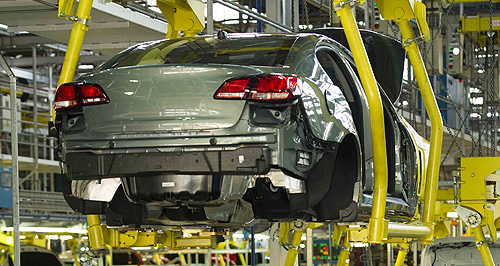Make / Model Search
News - General News - PartsCar industry closure would cost $21.5 billionBig hit: A report by the Federal Chamber of Automotive Industries is predicting a big impact on the Australian economy if car manufacturing ceases. Melbourne, Adelaide would be “devastated” by car industry closure, says study4 Nov 2013 By IAN PORTER A NEW study claims that closing the Australian car industry would cost the economy around $21.5 billion over a decade in lost investment, lost production and welfare payments to unemployed workers. The regional economies in Melbourne and Adelaide would be devastated, it says, and the whole Australian economy would take more than 10 years to recover. The cost of closing the industry would dwarf the $500 million a year that the car industry co-investment plan costs by assisting car and parts makers with new capital projects and models. The study was commissioned by the Federal Chamber of Automotive Industries, the peak industry body that represents both the local manufacturers and the importers. The study is the result of economic analysis done by the Monash University’s Centre of Policy Studies and based on research by the Allen Consulting Group. The study looked at the cost of keeping the industry in Australia and the cost to the country if the industry closed in 2017-18. FCAI executive director Tony Weber said the study showed that a withdrawal of government support for the industry would result in the loss of high-technology jobs and skills. In addition, significant foreign direct investment would cease. It would not be directed to other industries in Australia, as suggested by some economic theories which claim the resources used by the car industry would be reallocated to other industries. “I want to be clear,” Mr Weber said. “Financial support for the car industry is an investment in Australia and this investment needs to be long-term. Without that investment, we lose these long lasting benefits.” It notes that assistance to the car industry is at historic lows in Australia. “At present, the automotive manufacturing industry receives around $500 million per year in government support,” the study reads. “This is a small amount compared to the support given to automotive manufacturing in other countries and compared to when the industry in Australia was protected from import competition through tariffs. “There is little or no doubt that, absent this support, the three major car companies will not invest in new models in Australia, and will instead make the investments elsewhere in the world.” The study points out that the assistance extended to the car industry is not only much more obvious than assistance given to other Australian industries, it is also much less than that provided to some other industry sectors. It gives as an example the fuel and energy tax benefits granted to primary industries, principally in the form of the diesel excise rebate. This costs $1.5 billion a year with more than $1 billion of that going to the mining industry. This is hidden away in Treasury’s Tax expenditure Statement. “As a result, the degree of public scrutiny associated with the Fuel and Energy tax benefits is much less than that associated with the direct assistance received by the automotive industry, even though they are over three times as large,” the study says. A comparison of assistance given to the car industry by different countries ranks Australia at the bottom, with the industry receiving just $18 for every person on Australia. The highest level of assistance found when the comparison was done in 2008 was $334 per person in Sweden. The comparison showed that the German car industry received five times the Australian level of assistance, the French industry more than eight times and the US industry almost 15 times the level of assistance seen in Australia. To put the annual cost of assistance to the industry in perspective, the study calculates cost of closing the industry is many times greater than the cost of keeping it open. “A shutdown of the Australian automotive manufacturing industry will lead to not just to a permanent loss of GDP (gross domestic product), but a loss in economic welfare (measured as loss of consumption expenditure) as well, amounting to $21.5 billion, or $934 per person,” the study says. The economic loss will be particularly severe in the automotive industry-intensive states of Victoria and South Australia, especially in Melbourne and Adelaide. “The economies of Adelaide and Melbourne would be devastated with GRP (gross regional product) contracted by up to 1.4 per cent. “It is likely GRP will be lower than current levels until the end of 2031, while employment could fall by around 1.5 per cent.” “Important, but not readily captured in an economic model, are the severely concentrated negative social impacts in areas of high youth unemployment and high automotive dependency if the automotive industry leaves Australia.”  Read more1st of November 2013  Industry minister goes on the defensiveMacfarlane accuses Weatherill of playing politics with local car industry31st of October 2013  Car-making inquiry sets March 2014 deadlineGovernment hopeful of ensuring “ongoing viability” of car industry after inquiry30th of October 2013  Minister visits Toyota in Japan for crucial talksMacfarlane personally briefs Toyota on special inquiry into future of car industry23rd of October 2013  ‘Heartening’ talks on Toyota factory futureVictorian premier hears Toyota’s concerns for Altona plant in Japan summit15th of October 2013  Toyota cuts 100 more jobs at AltonaExport dip forces more job cuts at Toyota’s Altona plant as company debates future |
Click to shareGeneral News articlesResearch General News Motor industry news |











Facebook Twitter Instagram